Catholic Customs
 |
 |
 |
 |
 |
 |
 |
St. Joseph: the Harbinger of Spring
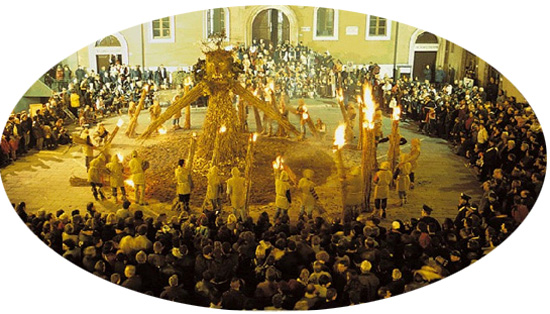
“It is on this day that Joseph, whose praises we the faithful now gladly tell,
And whose triumph we sing, deserved to receive the joys of eternal life.”
(Iste quem laeti colimus fideles,
Lauds Hymn, Feast of St. Joseph)
Every Catholic soul delights to hear of the grandeur of St. Joseph who, according to tradition, died on March 19. How marvelous that his death should occur at the time of the Spring Equinox (March 21) when Winter must accede to Spring the cold reign that it has held over the world.
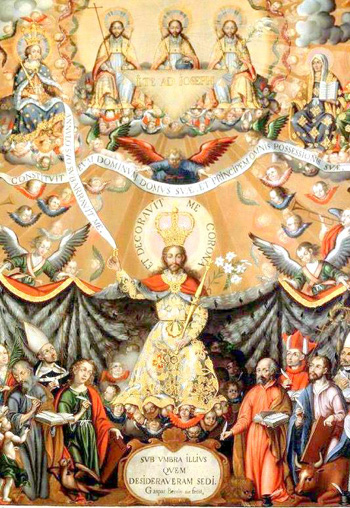
St. Joseph is crowned by Our Lord & Our Lady
The significance of the end of Winter was felt deeply by the people of the past, who rejoiced at the approach of Spring which brought new life and renewed hope. They commemorated this day with special ceremonies and customs to express that joy. The Germans had this charming proverb: 'St Joseph shakes his beard, and see, Winter has disappeared!' (1)
To ensure St. Joseph’s blessings on the bees, beekeepers from Central Europe went to their hives on this day and tapped the hives with a stick to “awaken” the bees and symbolically ask God for a good year of honey. (2) The Hungarian beekeepers greeted the bees with these words, “In the name of God the Father, the Son, the Holy Spirit, go, load up, bring in all the honey!” (3)
In some regions of France, this was the day when springs and creeks were blessed after being frozen all Winter. On St. Joseph’s Day, the French people said, the birds found their mates. (4)
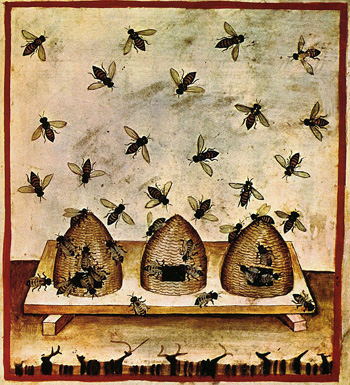
The bees awaken to buzz on this day, adding their praise of St. Joseph
In the countryside of Central Europe, the farmers constructed shrines in their gardens and orchards and lit candles in St. Joseph’s honor. Then, priests processed through these farmers’ fields to bless them so that the coming Spring and planting season would be under St. Joseph’s powerful patronage. (5)
Indeed, what better way to prepare for the graces of Spring and Easter than by placing the season under the patronage of the man who nurtured and raised Our Lord to the fullness of His manhood.
Bonfires of St. Joseph
Joyous to see the end of Winter and the grandeur of St. Joseph, Catholics in Spain and Italy lit great bonfires. Remnants of the last harvest – such as branches of vines, olive trees and other woody crops – served as fuel for the fires that brought hope for a new harvest. Friendly competitions often emerged between neighboring villages as each village attempted to build the largest bonfire.

The bonfire & torch lit procession to St. Joseph in Pitigliano, Italy
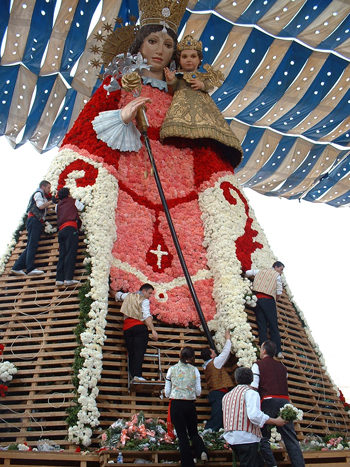
Our Lady receives due tribute on this day with a huge flower covered dress for the procession in Valencia
As the years went by, the St. Joseph celebrations became more and more elaborate with processions, bullfights, parades, and the constructing of elaborate wooden towers on which were erected various effigies and scenes made of canvas, plaster, and paper mâché.
The glorious hour for lighting the bonfires was midnight on March 19. When the darkness was at its height and the night at its middle, the blackness was suddenly broken by the flashing color of large bonfires set ablaze. The people danced and sang around the fires and rejoiced in the glories of the great St. Joseph. (6)
Today, these celebrations are continued in Valencia, but the wooden towers are often grotesque and the parades filled with immodest dress, causing the charm of the past festivals to be lost.
Fires are also still lit in many places in Italy; some Italians see them as reminders of St. Joseph attempting to keep the Christ Child warm during the cold nights in the cave of Bethlehem.
In the town of Pitigliano, men dress in medieval tunics and carry torches through the streets to the central plaza where a large effigy is erected representing Winter. The men light the effigy with their torches at the appointed moment when two of their number enter the plaza bearing a statue of St. Joseph. When the people see the image of their beloved Saint in the light of the burning flames, they rejoice exclaiming, “Evvi, Evvi, Evviva San Giuseppe” (Hurrah, Hurrah, Cheers to St. Joseph!). (7)
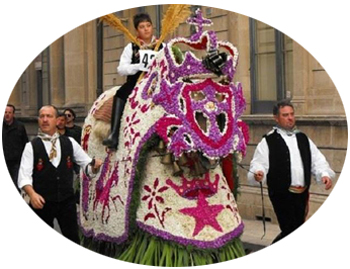
Beautifully adorned horses in Scicli in the Cavalcata procession
The glories of St. Joseph are indeed so immense that they merit grand celebrations in his honor. The verdant season of Spring rightly deserves to be under St. Joseph’s patronage. For what saint can better prepare the way for the feast of Our Blessed Mother’s Annunciation and the feast of Our Lord’s Resurrection than he who was chosen to be the faithful guardian of both.
Let us once again have recourse to St. Joseph in these first days of Spring and honor him by some gesture inspired by the customs of the past.
Continued
- http://kitchenlioness.blogspot.com/2020/03/sweet-cotton-bread-for-saint-josephs.html
- http://www.brauchtumskalender.at/brauch-162-josefitag
- https://www.arcanum.com/hu/online-kiadvanyok/MagyarNeprajz-magyar-neprajz-2/vii-nepszokas-nephit-nepi-vallasossag-A33C/szokasok-A355/jeles-napok-unnepi-szokasok-A596/marcius-A6B0/marcius-18-19-21-sandor-jozsef-benedek-A6C2/
- E. I. Robson, A Guide to French Fêtes (London: Methuen and Company, 1930), p. 79.
- Francis X Weiser, The Holyday Book (London: Staples Press Limited), p. 159.
- Dorothy Gladys Spicer, Festivals of Western Europe (New York: The H. W. Wilson Company, 1958), p. 201-202.
- https://passeiosnatoscana.com/folclore-torciata-di-san-giuseppe-em-pitigliano/
- https://italiantribune.com/a-saint-josephs-celebration-unlike-any-other-la-cavalcata-di-san-giuseppe/

Posted March 10, 2023
______________________
______________________
 |
 |
 |
 |
 |
 |


